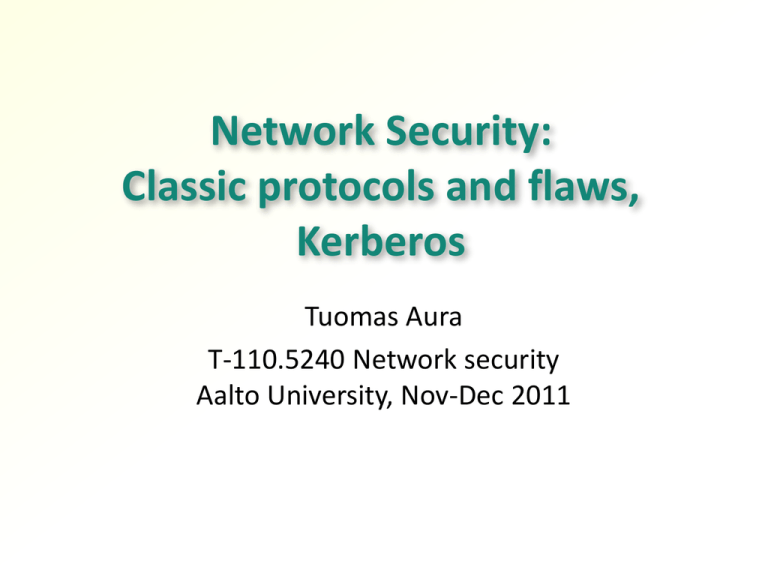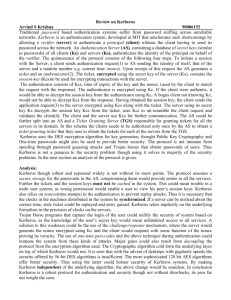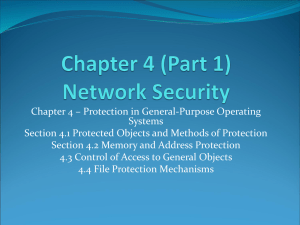Network Security
advertisement

Network Security: Classic protocols and flaws, Kerberos Tuomas Aura T-110.5240 Network security Aalto University, Nov-Dec 2011 Outline Classic key-exchange protocols and flaws Kerberos authentication Kerberos in Windows domains 2 Classic key-exchange protocols and flaws Needham-Schroeder secret-key protocol The first secret-key key-exchange protocol 1978 Kerberos is based on this protocol Trusted server T shares a secret master key with everyone. It distributes a session key encrypted with the master keys: 1. 2. 3. 4. 5. A → T: A, B, NA1 T → A: ETA(NA1, B, Kses, ticketAB) A → B: ticketAB, Eses(NA2) B → A: Eses(NA2-1, NB) A → B: E (NB-1) KTA, KTB = A’s and B’s master keys Kses = session key selected by T ticketAB = ETB(Kses,A) “Encryption” must also protect integrity 4 Needham-Schroeder analysis The protocol again: 1. 2. 3. 4. 5. A → T: A, B, NA1 T → A: ETA(NA1, B, Kses, ticketAB) A → B: ticketAB, Eses (NA2) B → A: Eses (NA2-1, NB) A → B: Eses (NB-1) // ticketAB = ETB(Kses,A) T encrypts session key under A’s and B’s master keys Authenticators in messages 4–5 for key confirmation NA1 guarantees freshness of ticket and session key to A NA2 and NB guarantee freshness of authenticators to A and B, respectively But no freshness of the ticket to B… 6 Needham-Schroeder vulnerability The protocol again: 1. 2. 3. 4. 5. A → T: A, B, NA0 T → A: ETA(NA0, B, Kses, ticketAB) A → B: ticketAB, Eses (NA) B → A: Eses (NA-1, NB) A → B: Eses (NB-1) // ticketAB = ETB(Kses,A) Vulnerability discovered by Denning and Sacco 1981 Freshness of the ticket not guaranteed to B Assume attacker compromises an old session key and has sniffed the corresponding ticket, or Or assume attacker compromises A’s master key KTA. A’s master key is replaced but, before that, the attacker manages to obtain a ticket for B Replay attack by C who knows an old session key, pretending to be A: 3’. C(A) → B: ticketAB-old, Eses-old (NA) 4’. B → C(A): Eses-old (NA-1, NB) 5’. C(A) → B: Eses-old (NB-1) // ticketAB-old = EKTB-old(Kses-old,A) Lesson: protocols should withstand compromise of old secrets How to fix? 7 Denning-Sacco protocol Public-key key exchange 1981; flaw found in 1994 A obtains certificates from trusted server T for both A’s and B’s public keys 1. A → T: A, B 2. T → A: CertA, CertB 3. A → B: EB(TA, Kses, SA(TA, Kses)), CertA, CertB Kses = session key selected by A EB = encryption with B’s public key CertA = A, PKA, ST (A, PKA) Analysis: Expiration time missing from certificates → should be added! Public-key encryption for secrecy of Kses → ok Time stamp for freshness → should do something about fast replays! Public-key signature for authentication → but what information exactly is authenticated? 8 Denning-Sacco vulnerability The protocol again: 1. A → T: A, B 2. T → A: CertA, CertB 3. A → B: EB(TA, Kses, SA(TA, Kses)), CertA, CertB The signed message SA(TA, KAB) does not contain all possible information What is missing? The signed message is not bound to the identity of B Does it matter when only B can decrypt the message? Yes because B could be bad! B can forward the last message to anyone else, e.g. to C: 3’. B(A) → C: EC(TA, KAB, SA(TA, KAB)), CertA, CertC C will think it shares Kses with A but it is really shared with B Legitimate user B can impersonate legitimate user A. Lesson: protocols should withstand insider attacks How to fix? 9 Needham-Schroeder public-key protocol The first public-key key-exchange protocol 1978; flaw found in 1995 [Lowe95] A and B know each other’s public encryption keys or obtain certificates from a trusted server T as needed. Then, A and B exchange key material: 1. A → B: EB(NA, A) 2. B → A: EA(NA, NB) 3. A → B: EB(NB) NA, NB = secret nonces, also serving as key material EA, EB = encryption with A’s or B’s public key Kses = h(NA, NB) Analysis: Session key secret and fresh; entity authentication ok Session key not bound to A 10 What is a protocol flaw? Researchers like to present spectacular attacks and flaws but the reality is often less black and white Limitations on the applicability of the protocol: Can the protocols withstand insider attacks? Should multiple parallel executions be allowed with the same peer? Is the protocol used for its original purpose or for something different? Requirements for implementations: Encryption mode in old protocols is often assumed to protect integrity (MAC or non-malleable encryption) Signed and MAC’d messages must include type tags and be parsed unambiguously New attacks and requirements arise over time: Man-in-the-middle attacks DoS protection, identity protection What next? E.g. firewall traversal, mobility support, load balancing in server farms, distribution to the cloud, session migration, ... 14 Kerberos authentication 15 Kerberos Shared-key protocol for user login authentication Uses passwords as shared keys Solves security and scalability problems in password-based authentication in large domains Based loosely on the Needham-Schroeder secret-key protocol Kerberos v4 1988- at MIT Kerberos v5 1993- [RFC 4120] Updated protocol and algorithms ASN.1 BER message encoding Implemented in Windows 2000 and later Used in intranets: e.g. university Unix systems, corporate Windows domains 16 Kerberos architecture (1) KDC 4. KRB_TGS_REP Application server B 5. KRB_AP_REQ 6. KRB_AP_REP Client A ap_client.exe ap_server.exe 3. KRB_TGS_REQ TGS 2. KRB_AS_REP 1. KRB_AS_REQ AS 1.–2. Authentication 3.–4. Ticket for a specific service 4.–5. Authentication to the service 17 Kerberos architecture (2) KDC Service ticket, KAB 4. KRB_TGS_REP TGT 3. KRB_TGS_REQ TGT, KAT 2. KRB_AS_REP 1. KRB_AS_REQ krbtgt@RealmY Application server B 5. KRB_AP_REQ Service ticket Client A A@RealmY 6. KRB_AP_REP ap_client.exe B@RealmY TGS ap_server.exe AS 1.–2. Authentication with password → client gets TGT and KAT 3.–4. Authentication with TGT and KAT → client gets service ticket and KAB 4.–5. Authentication with service ticket and KAB → client gets service access 19 Kerberos ticket Message type, version FLAGS KEY CNAME, CREALM Client name and realm TRANSITED transit realms AUTH-TIME, END-TIME CADDR Client IP address (optional) AUTORIZATION-DATA App-specific access constraints Encrypted with server’s master key REALM, SNAME Server name and realm Same format for both TGT and service ticket Credentials = ticket + key ASN.1 encoding in Kerberos v5 “Encryption” also protects integrity, actually encryption and a MAC Flags: FORWARDABLE, FORWARDED, PROXIABLE, PROXY, MAY-POST-DATE, POSTDATED, INVALID, RENEWABLE, INTINIAL, PRE-AUTHENT, HW-AUTHENT INITIAL flag indicates TGT 20 Protocol details Initial login of user A: 1. A → AS: 2. AS → A: Ticket request: 3. A → TGS: 4. TGS → A: Preauthentication, A, TGS, NA1, AddrA A, TGT, EKA (KA-TGS, NA1, TGS, AddrA) TGT, AuthenticatorA-TGS, B, NA2, AddrA A, Ticket, EKA-TGS (KAB, NA2, B, AddrA) Authentication to server B: 5. A → B: 6. B → A: Ticket, AuthenticatorAB AP_REP KA , KTGS, KB = master keys of A, TGS and B KA-TGS = shared key for A and TGS KAB = shared key for A and B TGT = B, EKTGS (INITIAL, KA-TGS, A, Tauth, Texpiry1, AddrA)) Ticket = B, EKB(KAB, A, Tauth, Texpiry2, AddrA)) Preauthentication = EKA (1 TA) AuthenticatorA-TGS = EKA-TGS (2 TA) AuthenticatorAB = EKAB (3 TA) AP_REP = EKAB(4 TA) AddrA = A’s IP addresses Notes: 1234) ASN.1 encoding adds type tags to all messages Encryption mode also protects message integrity 21 Kerberos realms Realm X Realm Y Cross-realm trust User registration User A Server B Users and services registered to one KDC form a realm name@realm, e.g. A@X, alice@asia.sales.contoso.com Cross-realm trust: Two KDCs X and Y share a key (krbtgt@Y is registered in KDC X and krbtgt@X in KDC Y) KDCs believe each other to be honest and competent to name users in their own realm Cross-realm authentication: Client A@X requests from TGS at realm X a ticket for TGS at realm Y The ticket is encrypted for krbtgt@Y (i.e. TGS at realm Y) Client A@X requests from TGS at realm Y a ticket for server B@Y Access control at several steps: Local policy at each KDC about when to honor tickets from other realms Local policy at B@Y about whether to allow access to users from other realms ACLs at B@Y determine whether the users is allowed to access the particular resources Possible to transit multiple realms → TRANSITED field in the ticket lists intermediate realms Local policy at each server about which transit realms are allowed 23 Realm hierarchy contoso.com dev.contoso.com sales.contoso.com Charlie euro.sales.contoso.com asia.sales.contoso.com Cross-realm trust Bob David Alice User registration Large organizations can have a realm hierarchy Hierarchy follows internet names → easy to find a path between realms → can filter cross-realm requests based on the names Can add shortcut links or create even a fully connected graph between KDCs E.g. Windows domain hierarchy Compare with X.509 certification hierarchy: similarities, differences? 24 Password guessing attacks Kerberos is vulnerable to password guessing: Sniffed KRB_AS_REQ or KRB_AS_REP can be used to test candidate passwords → offline brute-force password guessing In Kerberos v4, anyone could request a password-encrypted TGT from AS → easy to obtain material for password cracking Preauthentication in Kerberos v5 prevents active attacks to obtain material for password cracking → must sniff it Note: active vs. passive attacks Misleading thinking: active attacks (e.g. MitM) are more difficult to implement than passive attacks (sniffing) Reality: Active attacks can often be initiated by the attacker while passive attacks require attacker to wait for something to sniff → vulnerability to such active attacks is serious 25 PKINIT Goal: take advantage of an existing PKI to bootstrap authentication in Kerberos Replaces the KRB_AS_REQ / KRB_AS_REP exchange with a public-key protocol Public-key authentication and encryption to obtain TGT Continue with standard Kerberos → transparent to TGS and application servers No password, so not vulnerable to password guessing Uses DSS signatures and ephemeral DH Windows 2000 and later, no standard [RFC 4556] 26 Delegation Server may need to perform tasks independently on the client’s behalf Recursive RPC; agents operating when the user is no longer logged in; batch processing at night Alice can give her TGT or service ticket and key to David Controlling the use of delegated rights in applications: Ticket may specify many allowed client IP addresses Authorization-data field in ticket may contain app-specific restrictions It is safer to delegate a service ticket than TGT Ticket flags related to delegation: FORWARDABLE flag in TGT: the TGT can be used to obtain a new TGT with different IP addresses PROXIABLE flag in TGT: the TGT can be used to obtain service tickets with a different IP address Kerberos delegation is identity delegation When B has A’s ticket and key, B can act as A and nobody can tell the difference → difficult to audit access; similar to sharing passwords 28 Kerberos in Windows domains Thanks to Dieter Gollmann 29 Kerberos ticket in Windows Message type, version FLAGS KEY Username, domain CNAME, CREALM Client name and realm TRANSITED transit realms AUTH-TIME, END-TIME User and group SIDs CADDR Client IP address (optional) AUTORIZATION-DATA App-specific access constrains Encrypted with server’s master key REALM, SNAME Server name and realm 34 Puzzle of the day (Hopefully most of you already know the answer to this puzzle.) Diffie-Hellman protocol based on a commutative arithmetic operation: A chooses a random x. B chooses a random y. 1. A → B: A, gx 2. B → A: B, gy A calculates Kses = (gy)x = gxy. B calculates Kses = (gx)y = gxy. Security based on the computational Diffie-Hellman assumption: given g, gx and gy, it is infeasible to solve gxy (Note: The calculations are done in some pre-agreed finite cyclic group where g is a generating element.) Looks simple and attractive, but what is wrong with this key exchange? Write down the attack 35 Related reading William Stallings. Network security essentials: applications and standards, 3rd ed.: chapter 4.1 (Kerberos v5) William Stallings. Cryptography and Network Security, 4th ed.: chapters 14.1 (Kerberos v5) Kaufmann, Perlman, Speciner. Network security, 2nd ed.: chapter 14 Ross Anderson. Security Engineering, 2nd ed.: chapter 3 Dieter Gollmann. Computer Security, 2nd ed.: chapter 12.4 36 Exercises Find source code for a Kerberized client/server application (e.g. telnet) and see how it accesses Kerberos services Why is Kerberos used on the intranets and TLS/SSL on the Internet? Could it be the other way? 37




